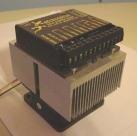The CPU consists of a single microchip mounted on a supporting structure of connector pins. It is these pins that mate up with the CPU socket on the motherboard and through these pins that the CPU can communicate with the other
 electronic components either integrated into the mother
electronic components either integrated into the mother board or connected to the motherboard. The pictures on the left show an actual Intel Pentium 4 CPU. The picture furthest left is of the underside of the chip and shows the array of pins around the processor that will plug into the motherboard CPU socket. The picture near left shows the top of the CPU as it would appear when inserted in the motherboard.
board or connected to the motherboard. The pictures on the left show an actual Intel Pentium 4 CPU. The picture furthest left is of the underside of the chip and shows the array of pins around the processor that will plug into the motherboard CPU socket. The picture near left shows the top of the CPU as it would appear when inserted in the motherboard.In addition to Intel, there is really only one other player when it comes to
 CPUs for PCs and that is AMD. AMD has been the arch rival of Intel for many years and has steadily increased its market share. AMD CPUs are generally cheaper than Intel equivalents and this has led to their acceptance by value-based manufacturers such as Dell and Packard Bell.
CPUs for PCs and that is AMD. AMD has been the arch rival of Intel for many years and has steadily increased its market share. AMD CPUs are generally cheaper than Intel equivalents and this has led to their acceptance by value-based manufacturers such as Dell and Packard Bell.Irrespective of whether your PC has Intel or AMD inside (and both are equivalent in terms of what they can do and reliability) what determines how fast the CPU runs is the clock speed. Every computer contains an internal clock that regulates the rate at which instructions are executed and synchronizes all the various computer components. The CPU requires a fixed number of clock ticks (or clock cycles) to execute each instruction. The faster the clock, the more instructions the CPU can execute per second. Clock speeds are expressed in megahertz (MHz) or more commonly gigahertz (GHz). If you have purchased your PC in the last two years it will probably have CPU that runs at a clock speed of between 2.0 and 3.4 GHz. If your PC is 6-7 years old then its CPU may be running at 400-800 MHz. The higher the clock speed of your CPU the faster your PC is capable of running (though other factors can affect the actual performance of your PC).
It's difficult to talk about CPUs and not talk about heatsinks as the two are practically inseparable. Modern CPUs generate a lot of heat, particularly as the clock speeds have increased. In fact they now generate so much heat during normal operation that they would burn out in a few seconds if that heat was not efficiently removed. And that is the role of the heatsink. If you open up any modern PC and look for the CPU you will not be able to see it - the reason for this is that a heatsink is firmly bolted to the top of the CPU chip to draw away the heat it generates. Heat sinks come in many different shapes and sizes, but they all work on the same principle. A heatsink consists of a large piece of heat conducting metal (normally aluminium or copper, both of which are efficient conductors of heat). The piece of metal will have one side milled to a mirror-smooth surface and this is placed in contact with the top of the CPU. Between the two there will normally be a thin layer of a heat conducting paste. The top of our block of metal will normally be shaped to present a large surface area which dissipates the heat to the air and a fan is generally fitted to assist with the dissipation of heat. Here are some pictures of heatsinks.




The CPU is generally the singularly most expensive component in the PC, even though it is arguably the smallest physical component, and can represent over 50% of the cost of your computer. A replacement 3.2 GHz Pentium 4 CPU is currently listed at €420. Failure of CPUs is uncommon, but can happen, often as a result of overheating due to impaired ventilation.
Tomorrow we'll talk about RAM (memory, not male sheep).
No comments:
Post a Comment